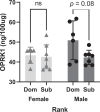PET imaging of kappa opioid receptors and receptor expression quantified in neuron-derived extracellular vesicles in socially housed female and male cynomolgus macaques
- PMID: 36100655
- PMCID: PMC9751296
- DOI: 10.1038/s41386-022-01444-9
PET imaging of kappa opioid receptors and receptor expression quantified in neuron-derived extracellular vesicles in socially housed female and male cynomolgus macaques
Abstract
Recent positron emission tomography (PET) studies of kappa opioid receptors (KOR) in humans reported significant relationships between KOR availability and social status, as well as cocaine choice. In monkey models, social status influences physiology, receptor pharmacology and behavior; these variables have been associated vulnerability to cocaine abuse. The present study utilized PET imaging to examine KOR availability in socially housed, cocaine-naïve female and male monkeys, and peripheral measures of KORs with neuron-derived extracellular vesicles (NDE). KOR availability was assessed in dominant and subordinate female and male cynomolgus macaques (N = 4/rank/sex), using PET imaging with the KOR selective agonist [11C]EKAP. In addition, NDE from the plasma of socially housed monkeys (N = 13/sex; N = 6-7/rank) were isolated by immunocapture method and analyzed for OPRK1 protein expression by ELISA. We found significant interactions between sex and social rank in KOR availability across 12 of 15 brain regions. This was driven by female data, in which KOR availability was significantly higher in subordinate monkeys compared with dominant monkeys; the opposite relationship was observed among males, but not statistically significant. No sex or rank differences were observed for NDE OPRK1 concentrations. In summary, the relationship between brain KOR availability and social rank was different in female and male monkeys. This was particularly true in female monkeys. We hypothesize that lower [11C]EKAP binding potentials were due to higher concentrations of circulating dynorphin, which is consistent with greater vulnerability in dominant compared with subordinate females. These findings suggest that the KOR is an important target for understanding the neurobiology associated with vulnerability to abused drugs and sex differences, and detectable in peripheral circulation.
© 2022. The Author(s), under exclusive licence to American College of Neuropsychopharmacology.
Conflict of interest statement
The authors declare no competing interests.
Figures


Similar articles
-
Effects of Long-Term Cocaine Self-Administration on Kappa Opioid Receptors in Socially Housed Cynomolgus Monkeys as Assessed With Positron Emission Tomography Imaging and Neuronally Derived Exosomes.Biol Psychiatry. 2025 Mar 5:S0006-3223(25)01014-5. doi: 10.1016/j.biopsych.2025.02.900. Online ahead of print. Biol Psychiatry. 2025. PMID: 40054763
-
Delay discounting as a behavioral phenotype associated with social rank in female and male cynomolgus monkeys: Correlation with kappa opioid receptor availability.Pharmacol Biochem Behav. 2023 Apr;225:173545. doi: 10.1016/j.pbb.2023.173545. Epub 2023 Mar 31. Pharmacol Biochem Behav. 2023. PMID: 37004977 Free PMC article.
-
Differences in D2 dopamine receptor availability and reaction to novelty in socially housed male monkeys during abstinence from cocaine.Psychopharmacology (Berl). 2010 Mar;208(4):585-92. doi: 10.1007/s00213-009-1756-4. Psychopharmacology (Berl). 2010. PMID: 20066401 Free PMC article.
-
Imaging Kappa Opioid Receptors in the Living Brain with Positron Emission Tomography.Handb Exp Pharmacol. 2022;271:547-577. doi: 10.1007/164_2021_498. Handb Exp Pharmacol. 2022. PMID: 34363128 Review.
-
Dynorphin/Kappa Opioid Receptor Signaling in Preclinical Models of Alcohol, Drug, and Food Addiction.Int Rev Neurobiol. 2017;136:53-88. doi: 10.1016/bs.irn.2017.08.001. Epub 2017 Sep 12. Int Rev Neurobiol. 2017. PMID: 29056156 Review.
Cited by
-
Cognitive performance as a behavioral phenotype associated with cocaine self-administration in female and male socially housed monkeys.Neuropsychopharmacology. 2024 Oct;49(11):1729-1737. doi: 10.1038/s41386-024-01882-7. Epub 2024 May 17. Neuropsychopharmacology. 2024. PMID: 38760425 Free PMC article.
-
A Liquid Biopsy-Based Approach to Isolate and Characterize Adipose Tissue-Derived Extracellular Vesicles from Blood.ACS Nano. 2023 Jun 13;17(11):10252-10268. doi: 10.1021/acsnano.3c00422. Epub 2023 May 24. ACS Nano. 2023. PMID: 37224410 Free PMC article.
-
PET imaging of dopamine transporters and D2/D3 receptors in female monkeys: effects of chronic cocaine self-administration.Neuropsychopharmacology. 2023 Sep;48(10):1436-1445. doi: 10.1038/s41386-023-01622-3. Epub 2023 Jun 22. Neuropsychopharmacology. 2023. PMID: 37349473 Free PMC article.
-
Neuron-derived extracellular vesicles as a liquid biopsy for brain insulin dysregulation in Alzheimer's disease and related disorders.Alzheimers Dement. 2025 Feb;21(2):e14497. doi: 10.1002/alz.14497. Epub 2025 Jan 17. Alzheimers Dement. 2025. PMID: 39822132 Free PMC article. Review.
-
Acquisition of cocaine reinforcement using fixed-ratio and concurrent choice schedules in socially housed female and male monkeys.Psychopharmacology (Berl). 2024 Feb;241(2):263-274. doi: 10.1007/s00213-023-06483-8. Epub 2023 Oct 26. Psychopharmacology (Berl). 2024. PMID: 37882812 Free PMC article.
References
-
- UNODC, Treatment of Stimulant Use Disorders: Current Practicies and Promising Perspectives, U.N.O.o.D.a. Crime, Editor. 2019.
-
- SAMHSA, Key substance use and mental health indicators in the United States: Results from the 2018 National Survey on Drug Use and Health. (HHS Publication No. PEP19-5068, NSDUH Series H-54). Rockville, MD: Center for Behavioral Health Statistics and Quality, Substance Abuse and Mental Health Services Administration, 2019.
-
- Buddy T. How Drug Use Affects Our Society. 2019.
Publication types
MeSH terms
Substances
Grants and funding
LinkOut - more resources
Full Text Sources

